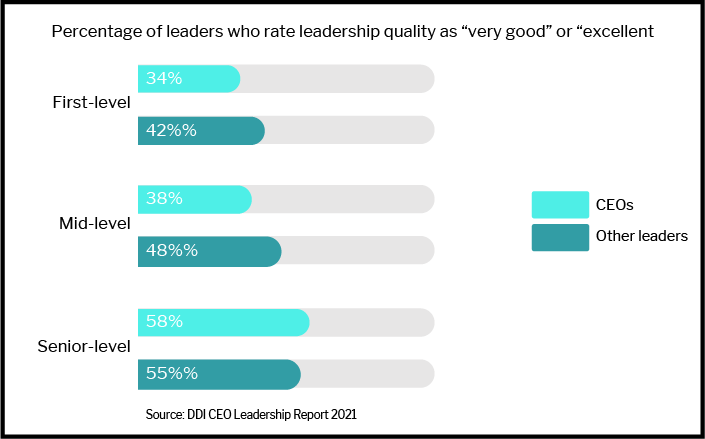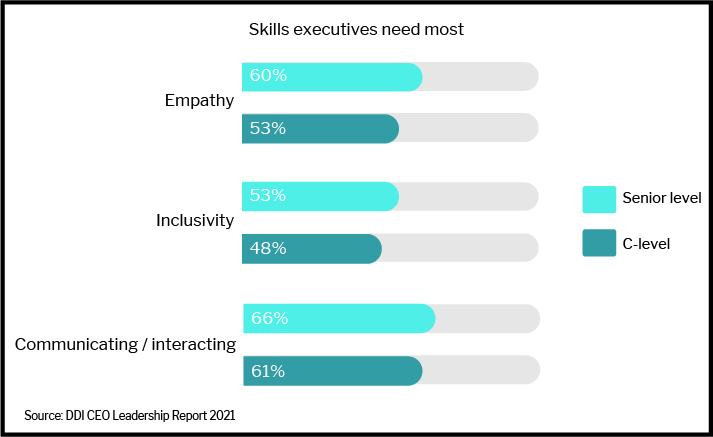Leadership Is Lacking - The CEO Report
The recent CEO Leadership Report 2021 from Development Dimensions International analyses responses from 368 CEOs and 2,102 human resource executives around the world to understand if they are positioned to deal with the one of the most challenging times ever experienced by businesses. Do they have the resilience, capability, and agility to drive a successful outcome for their organisation in these unprecedented times?
This article is my analysis and conclusion from the results.
Leading through change
CEOs lack confidence in their leaders
Only one in three CEOs (34%) said their organisation’s frontline leadership quality was “very good” or “excellent.” Only 38% rated their mid-level leadership quality as high.
I don’t think these CEOs are out of touch, I think they are right, if not over optimistic, regarding the capability of their leaders.
Front-line and mid-level leaders are facing challenges never faced before. The pandemic has changed the way we work forever. There is no going back to the way it was. The future of work is the future of leadership, and most leaders are not future ready.
This is uncharted territory, and there is no playbook, standard operating procedure, or guidebook for leaders to follow. Most leaders are suddenly being confronted with the need to lead a hybrid team for the first time. There are a multitude of variations of the hybrid working model and therefore there is no cookie-cutter approach to leverage.
Leaders of hybrid teams need elevated competencies in the areas of communication and engagement; inclusivity and equity; performance measurement; empowering employees and providing autonomy. There are fundamental foundations for a successful hybrid team that leaders will have to establish if they do not already exist and these include trust and mutual respect, psychological safety, and positive reinforcement.
This is a challenge that can be met face on with leadership development, coaching and feedback programs.
Leadership development has always been lacking as revealed in Harvard Business Review research. Most leaders become a leader in their late 20s or early 30s and receive their first leadership development when they are 42. This gives them over a decade to embed bad habits they learned from their leader who experienced the same! This is the time for change. My experience is that most leaders are open to learning and developing new skills and capabilities if given the opportunity.
The CEO must increase the quality of leadership through investment in a comprehensive and contextual program of leadership development.
Leaders lack resilience
The report also revealed a crisis of confidence. As the report stated “Confidence is contagious. But so is doubt.” What this means is that when leaders feel confident about their ability to lead, others do too.
When CEOs have above average confidence, 54% are effective at influencing compared to the 21% with below average confidence. When CEOs have above average confidence, 54% are effective at delegating and empowering compared with 26% with below average confidence.
When tested by a crisis such as COVID-19, CEOs confidence wavered and so did that of their leaders. Executives self-reported that their influence and communication skills decreased by more than 20% during the crisis. Their self-rating of ability to create an inclusive environment decreased by 25%.
CEOs and their leadership teams need to develop their resilience to lead during good time and bad.
Resilient leaders are adaptive leaders and able to manage rapid change and guide their organisation in the right direction. They are agile and flexible, being able to change direction as needed. They effectively empower their employees and provide autonomy and do not inadvertently pull back tight control when a crisis hits. Their influencing and communication effectiveness is not diminished during a crisis but rather heightened. They provide a shared sense of purpose, common and aligned goals and a clear direction. They lead with empathy and compassion, are authentic and build teams that are also resilient in the face of constant, uncertain, and unprecedented change.
The CEO must increase workforce resilience through investment in the development of leadership and team resilience.
The most needed skills are missing
C-level leaders struggle with key leadership skills including empathy, inclusivity and communicating / interacting.
Whilst these could be considered basic leadership skills, the DDI research found their effectiveness to be questionable.
Only 53% of C-level executive said they were effective at demonstrating empathy. Only 61% said they were very effective at communicating and interacting with others. These numbers dropped when it came to creating an inclusive environment, with only 48% of C-level execs reporting effectiveness.
The report speculated that C-level executives find the pressure to perform these skills well in top roles is highly amplified and they find themselves coming up short in meeting the higher standards. It also concluded that a lack of development in these areas was a core contributor.
CEOs need to invest in their own soft skill development and that of their leadership teams. When C-level leaders can demonstrate empathy, foster inclusion, develop future talent, and communicate effectively, they can keep their organisation on track to meet strategic objectives.
C-level leaders receiving formal training indicate their companies are 1.6 times more likely to be in the top 5% of financial performers compared to those without formal training.
Invest in leadership development of soft skills that can transcend the complexity of change and disruption.
Influence behind purpose
Senior leaders often underestimate their ability to influence purpose and engagement of the organisation’s leadership.
The research found that when leaders perceive their senior leadership to be of high quality, they are more than twice as likely to report being engaged in their leadership roles compared to those who rate their leaders as low quality.
They are also 1.5 times more likely to find their jobs full of meaning and purpose and feel that they have a valued part of play in the achievement of the organisation’s strategic objectives.
There is clearly a cascade effect happening here. Invest in your senior leadership and it will have a direct impact on the rest of the leadership.
Leaders at every level of the organisation have been impacted by the changes and disruption brought about by COVID-19. The speed of change, the uncertainty and its unprecedented nature will not go away post-pandemic. The next great disruption is right around the corner, and we will not see it coming. We just must be prepared for it.
DDI found eight key factors that boost senior leadership effectiveness which in turn will influence the purpose and engagement of other leaders in the organisation.
1. Senior executives operate as an effective team to drive the strategy forward.
2. Companies have an effective leadership strategy.
3. Leaders have strong interpersonal skills.
4. Flexible work arrangements are common and supported.
5. Leaders challenge self and others to recognize and eliminate biases.
6. Leaders are promoted based on merit.
7. Leaders are accelerated from all functions and parts of the organization.
8. Inclusion of different perspectives is a strong component of the company’s culture and values.
Leadership effectiveness needs to be intentionally developed. Leaders at every level of the organisation will have a wide-spread and mushrooming impact on organisational leadership capability.
Leadership development is never done
The DDI research revealed an aspect of leadership development that I have witnessed across many organisations. Most leadership development takes place for new leaders and diminishes over time as leaders gain more tenure in their roles. It diminishes as they take up more senior leadership positions.
A new leader does not learn everything they will ever need to know early in their career. They need continual education and development to enhance existing skills and establish new ones. We have already witnessed the need for differing leadership skills during the pandemic and that need will continue as the world continues to change and leaders ascend to higher levels and varied roles.
Only 35% of senior executives received any coaching during their transition. Only 25% were assigned a formal mentor or coach
Fewer than half of executives (49%) said they went through an assessment to identify their strengths and areas for improvement. This means too few of executives are receiving feedback to inform their development and their preparation for more senior roles.
The organisation must establish a formal program of leadership development at all levels of leadership including the most senior position.
Coaching and mentoring, assessments and feedback, and leadership training must be a continual process if the organisation is serious about having people who can lead into the future and through the changes that will need to happen.
The results are evident in the report.
Senior executives who had high-quality assessments for their transitions:
· Had 20% speedier transitions to their current roles
· Were 46% more likely to report their work in their new role energises them (71% vs. 49%)
· Were 83% less likely to have a stressful transition
It is time to get serious about leadership capability and stop leaving it to chance.
Summary
Leadership development must be comprehensive and contextual – not piecemeal and left to the tenacity of an individual.
A formal leadership development program must be in place at every level of leadership.
Leaders must develop the soft skills needed to effectively lead through every situation however that may present itself.
If you would like to discuss this article and your response in more detail, please get in touch.





